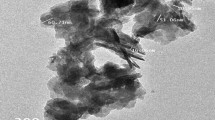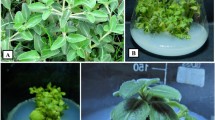Abstract
The high prevalence of extended-spectrum β-lactamases (76.3 %) and metallo-β-lactamases (7.3 %) amongst the bacteria Pseudomonas aeruginosa is a critical problem that has set forth an enormous therapeutic challenge. The suggested role of nanoparticles as next generation antibiotics, and inadequate information on antibacterial activity of aluminium oxide nanoparticles has led us to investigate the green synthesis of aluminium oxide nanoparticles (Al2O3 NPs) using leaf extracts of lemongrass and its antibacterial activity against extended-spectrum β-lactamases and metallo-β-lactamases clinical isolates of P. aeruginosa. The synthesized Al2O3-NPs were characterized by scanning electron microcopy, high resolution-transmission electron microscopy, atomic force microscopy, X-ray diffraction, Zeta potential, and differential light scattering techniques. The X-ray diffraction data revealed the average size of the spherical Al2O3-NPs as 34.5 nm. The hydrodynamic size in Milli Q water and Zeta potential were determined to be 254 nm and +52.2 mV, respectively. The minimal inhibitory concentration of Al2O3-NPs was found to be in the range of 1,600–3,200 µg/ml. Treatment at concentrations >2,000 µg/ml, resulted in complete growth inhibition of extended-spectrum β-lactamases and metallo-β-lactamases isolates. Scanning electron microcopy analysis revealed the clusters of nanoparticles attached to the bacterial cell surface, causing structural deformities in treated cells. High resolution-transmission electron microscopy analysis confirmed that nanoparticles crossed the cell membrane to become intracellular. The interaction of nanoparticles with the cell membrane eventually triggered the loss of membrane integrity, most likely due to intracellular oxidative stress. The data explicitly suggested that the synthesized Al2O3-NPs can be exploited as an effective bactericidal agent against extended-spectrum β-lactamases, non-extended-spectrum β-lactamases and metallo-β-lactamases strains of P. aeruginosa, regardless of their drug resistance patterns and mechanisms. The results elucidated the clinical significance of Al2O3-NPs in developing an effective antibacterial therapeutic regimen against the multi-drug resistant bacterial infections. The use of leaf extract of lemongrass for the synthesis of Al2O3-NPs appears to be cost effective, nontoxic, eco-friendly and its strong antibacterial activity against multi-drug resistant strains of P. aeruginosa offers compatibility for pharmaceutical and other biomedical applications.







Similar content being viewed by others
References
Adams LK, Lyon DY, Alvarez JJ (2006) Comparative ecotoxicity of nanoscale TiO2, SiO2, and ZnO water suspensions. Water Res 40:3527–3532
Ansari MA, Khan HM, Khan AA, Sultan A, Azam A, Shahid M, Shujatullah F (2011) Evaluation of antibacterial activity of silver nanoparticles against MSSA and MRSA on isolates from skin infections. Biol Med 3:141–146
Ansari MA, Khan HM, Khan AA, Sultan A, Azam A (2012a) Synthesis and characterization of the antibacterial potential of ZnO nanoparticles against extended-spectrum β-lactamases-producing Escherichia coli and Klebsiella pneumoniae isolated from a tertiary care hospital of North India. Appl Microbiol Biotechnol 94:467–477
Ansari MA, Khan HM, Khan AA, Sultan A, Azam A (2012b) Characterization of clinical strains of MSSA, MRSA and MRSE isolated from skin and soft tissue infections and the antibacterial activity of ZnO nanoparticles. World J Microbiol Biotechnol 28:1605–1613
Ansari MA, Khan HM, Khan AA, Pal R, Cameotra SS (2013) Antibacterial potential of Al2O3 nanoparticles against multi drug resistance strains of Staphylococcus aureus isolated from skin exudates. J Nanopart Res. doi:10.1007/s11051-013-1970-1
Ansari MA, Khan HM, Khan AA, Ahmad MK, Mahdi AA, Pal R, Cameotra SS (2014a) Interaction of silver nanoparticles with Escherichia coli and their cell envelope biomolecules. J Basic Microbiol 54(9):905–915
Ansari MA, Khan HM, Khan AA, Cameotra SS, Saquib Q, Musarrat J (2014b) Interaction of Al2O3 nanoparticles with Escherichia coli and their cell envelope biomolecules. J Appl Microbiol 116(4):772–783
Ansari MA, Khan HM, Khan AA, Cameotra SS, Saquib Q, Musarrat J (2014c) Gum arabic capped-silver nanoparticles inhibit biofilm formation by multi-drug resistant strains of Pseudomonas aeruginosa. J Basic Microbiol 54:688–699
Balasubramanyam A, Sailaja N, Mahboob M, Rahman MF, Hussain SM, Grover P (2010) In vitro mutagenicity assessment of aluminium oxide nanomaterials using the Salmonella microsome assay. Toxicol In Vitro 24:1871–1876
Bereket W, Hemalatha K, Getenet B, Wondwossen T, Solomon A, Zeynudin A, Kannan S (2012) Update on bacterial nosocomial infections. Euro Rev Med Pharmacol Sci 16:1039–1044
Bush K (2001) New beta-lactamases in gram-negative bacteria: diversity and impact on the selection of antimicrobial therapy. Clin Infect Dis 32:1085–1089
Bush K, Jacoby GA, Medeiros AA (1995) A functional classification scheme for β-lactamases and its correlation with molecular structure. Antimicrob Agents Chemother 39:1211–1233
CLSI (2006) Performance standards for antimicrobial susceptibility testing, Fifteenth Informational Supplement, CLSI document, M100-S16, vol 26-3; M7-A7, vol 26-2; M2-A9, vol 26-1. Wayne, PA, US
Driscoll CT, Schecher WD (1990) The chemistry of aluminum in the environment. Environ Geochem Health 12:28–50
Dundar D, Otkun M (2010) In-vitro efficacy of synergistic antibiotic combinations in multidrug resistant Pseudomonas aeruginosa strains. Yonsei Med J 51:111–116
Franco MR, Caiaffa-Filho HH, Burattini MN, Rossi F (2010) Metallo-beta-lactamases among imipenem-resistant Pseudomonas aeruginosa in a Brazilian university hospital. Clinics (Sao Paulo) 65:825–829
Griffitt RJ, Luo J, Gao J, Bonzongo JC, Barber DS (2008) Effects of particle composition and species on toxicity of metallic nanomaterials in aquatic organisms. Environ Toxicol Chem 27:1972–1978
Huh AJ, Kwon YJ (2011) “Nanoantibiotics”: a new paradigm for treating infectious diseases using nanomaterials in the antibiotics resistant era. J Control Release 156:128–145
Jiang W, Mashayekhi H, Xing B (2009) Bacterial toxicity comparison between nano- and micro-scale oxide particles. Environ Pollut 157:1619–1625
Johnston HJ, Hutchison G, Christensen FM, Peters S, Hankin S, Stone V (2010) A review of the in vivo and in vitro toxicity of silver and gold particulates: particle attributes and biological mechanisms responsible for the observed toxicity. Crit Rev Toxicol 40:328–346
Keller AA, Wang H, Zhou D, Lenihan HS, Cherr G, Cardinal BJ, Miller R, Ji Z (2010) Stability and aggregation of metal oxide nanoparticles in natural aqueous matrices. Environ Sci Technol 44:962–1967
Lagatolla C, Edalucci E, Dolzani L, Riccio ML, Luca FD, Medessi E, Rossolini GM, Tonin EA (2006) Molecular evolution of metallo-β-lactamase-producing Pseudomonas aeruginosa in a nosocomial setting of high-level endemicity. J Clin Microbiol 44:2348–2353
Lee K, Chong Y, Shin HB, Kim YA, Yong D, Yum JH (2001) Modified Hodge and EDTA-disk synergy tests to screen metallo-beta-lactamase-producing strains of Pseudomonas and Acinetobacter species. Clin Microbiol Infect 7:88–91
Lee K, Lee WG, Uh Y, Ha AY, Cho J, Chong Y (2003) VIM- and IMP-type metallo-β-lactamase-producing Pseudomonas spp. and Acinetobacter spp. in Korean hospitals. Emerg Infect Dis 9:868–871
Li M, Zhu L, Lin D (2011) Toxicity of ZnO nanoparticles to Escherichia coli: mechanism and the influence of medium components. Environ Sci Technol 45:1977–1983
Liu X, Luo L, Ding Y, Xu Y (2011) Amperometric biosensors based on alumina nanoparticles-chitosan-horseradish peroxidase nanobiocomposites for the determination of phenolic compounds. Analyst 136:696–701
Livermore DM (2002) Multiple mechanisms of antimicrobial resistance in Pseudomonas aeruginosa: our worst nightmare? Clin Infect Dis 34:634–640
Livermore DM, Woodford N (2000) Carbapenemases: a problem in waiting? Curr Opin Microbiol 3:489–495
Mansour HM, Rhee YS, Wu X (2009) Nanomedicine in pulmonary delivery. Int J Nanomed 4:299–319
Monteiro-Riviere NA, Oldenburg SJ, Inman AO (2010) Interactions of aluminum nanoparticles with human epidermal keratinocytes. J Appl Toxicol 30:276–285
Mukherjee A, Sadiq LM, Prathna TC, Chandreasekaran N (2011) Antimicrobial activity of aluminium oxide nanoparticles for potential clinical applications. In: Mendez-Vilas A (ed) Science against microbial pathogens: communicating current research and technological advances, vol. 1. FORMATEX Microbiology, Series No. 3, pp 245–251
Murdock RC, Braydich-Stolle L, Schrand AM, Schlager JJ, Hussain SM (2008) Characterization of nanomaterial dispersion in solution prior to in vitro exposure using dynamic light scattering technique. Toxicol Sci 101:239–253
Nel A, Xia T, Mädler L, Li N (2006) Toxic potential of materials at the nanolevel. Science 311:622–627
Pakrashi S, Dalai S, Sabat D, Singh S, Chandrasekaran N, Mukherjee A (2011) Cytotoxicity of Al2O3 nanoparticles at low exposure levels to a freshwater bacterial isolate. Chem Res Toxicol 24:1899–1904
Pakrashi S, Dalai S, Prathna TC, Trivedi S, Myneni R, Raichur AM, Chandrasekaran N, Mukherjee A (2013) Cytotoxicity of aluminium oxide nanoparticles towards fresh water algal isolate at low exposure concentrations. Aqua Toxicol 132:34–45
Papp-Wallace KM, Endimiani A, Taracila MA, Bonomo RA (2011) Carbapenems: past, present, and future. Antimicrob Agents Chemother 55:4943–4960
Paul M, Yahav D, Bivas A, Fraser A, Leibovici L (2010) Anti-pseudomonal beta-lactams for the initial, empirical, treatment of febrile neutropenia: comparison of beta-lactams. Cochrane Database Sys Rev 11:CD005197
Poole K (2011) Pseudomonas aeruginosa: resistance to the max. Front Microbiol 65:1–13
Qu TT, Zhang JL, Wang J, Tao J, Yu YS, Chen YG, Zhou JY, Li LJ (2009) Evaluation of phenotypic tests for detection of metallo-beta-lactamase-producing Pseudomonas aeruginosa strains in China. J Clin Microbiol 47:1136–1142
Queenan AM, Bush K (2007) Carbapenemases: the versatile beta-lactamases. Clin Microbiol Rev 20:440–458
Sader HS, Reis AO, Silbert S, Gales AC (2005) IMPs, VIMs and SPMs: the diversity of metallo-β-lactamases produced by carbapenem-resistant Pseudomonas aeruginosa in a Brazilian hospital. Clin Microbiol Infect 11:73–76
Sadiq MI, Chowdhury B, Chandrasekaran N, Mukherjeem A (2009) Antimicrobial sensitivity of Escherichia coli to alumina nanoparticles. Nanomedicine 5:282–286
Santos-Magalhães NS, Mosqueira VC (2010) Nanotechnology applied to the treatment of malaria. Adv Drug Deliv Rev 2:560–575
Sawai J, Igarashi H, Hashimoto A, Kokugan T, Shimizu M (1995) Evaluation of growth inhibitory effect of ceramics powder slurry on bacteria by conductance method. J Chem Eng Jpn 28:288–293
Shaikh S, Fatima J, Shakil S, Rizvi SMD, Kamal MA (2014) Prevalence of multidrug resistant and extended spectrum beta-lactamase producing Pseudomonas aeruginosa in a tertiary care hospital. Saudi J Biol Sci. doi:10.1016/j.sjbs.2014.06.001
Simon-Deckers A, Loo S, Mayne-L’hermite M, Herlin-Boime N, Menguy N, Reynaud C, Gouget B, Carriere M (2009) Size-, composition- and shape-dependent toxicological impact of metal oxide nanoparticles and carbon nanotubes toward bacteria. Environ Sci Technol 43:8423–8429
Skwarczynski M, Toth I (2011) Peptide-based subunit nanovaccines. Curr Drug Deliv 8:282–289
Sondi I, Salopek-Sondi B (2004) Silver nanoparticles as antimicrobial agent: a case study on E. coli as a model for Gram-negative bacteria. J Colloid Interface Sci 275:177–182
Sosnik A, Carcaboso AM, Glisoni RJ, Moretton MA, Chiappetta DA (2010) New old challenges in tuberculosis: potentially effective nanotechnologies in drug delivery. Adv Drug Deliv Rev 62:547–559
Thill A, Zeyons O, Spalla O, Chauvat F, Rose J, Auffan M, Flank AM (2006) Cytotoxicity of CeO2 nanoparticles for Escherichia coli. Physico-chemical insight of the cytotoxicity mechanism. Environ Sci Technol 40:6151–6156
Uyeda R (1991) Studies of ultrafine particles in Japan: crystallography. Methods of preparation and technological applications. Prog Mater Sci 35:96
Weir E, Lawlor A, Whelan A, Regan F (2008) The use of nanoparticles in anti-microbial materials and their characterization. Analyst 133:835–845
Yousefi S, Farajnia S, Nahaei MR, Akhi MT, Ghotaslou R, Soroush MH, Naghili B, Jazani NH (2010) Detection of metallo-β-lactamase-encoding genes among clinical isolates of Pseudomonas aeruginosa in northwest of Iran. Diagn Microbiol Infect Dis 68:322–325
Acknowledgments
The authors would like to acknowledge AIRF, Jawaharlal Nehru University, New Delhi, India, for SEM and SAIF-DST, Department of Anatomy, All India Institute of Medical Sciences (AIIMS), New Delhi, India, for HR-TEM analyses. Authors also would like to thank the Indian Council of Medical Research (ICMR) New Delhi, India, Grant No. 35/15/BMS-11 for their partial support and funding of this project.
Author information
Authors and Affiliations
Corresponding author
Rights and permissions
About this article
Cite this article
Ansari, M.A., Khan, H.M., Alzohairy, M.A. et al. Green synthesis of Al2O3 nanoparticles and their bactericidal potential against clinical isolates of multi-drug resistant Pseudomonas aeruginosa . World J Microbiol Biotechnol 31, 153–164 (2015). https://doi.org/10.1007/s11274-014-1757-2
Received:
Accepted:
Published:
Issue Date:
DOI: https://doi.org/10.1007/s11274-014-1757-2




